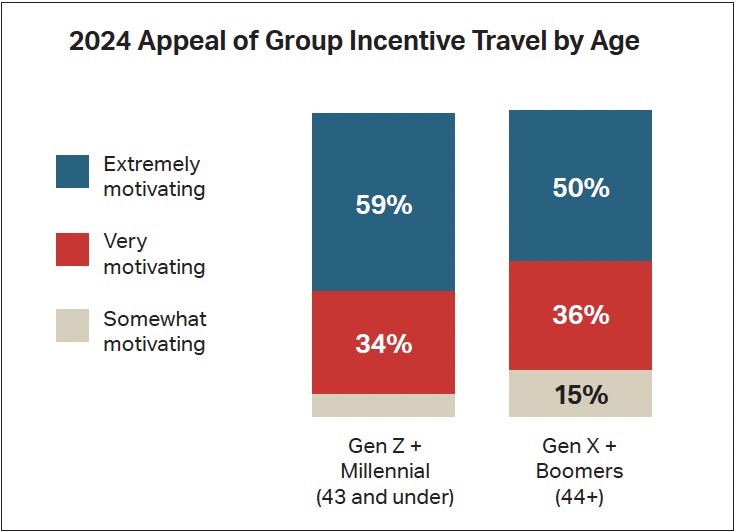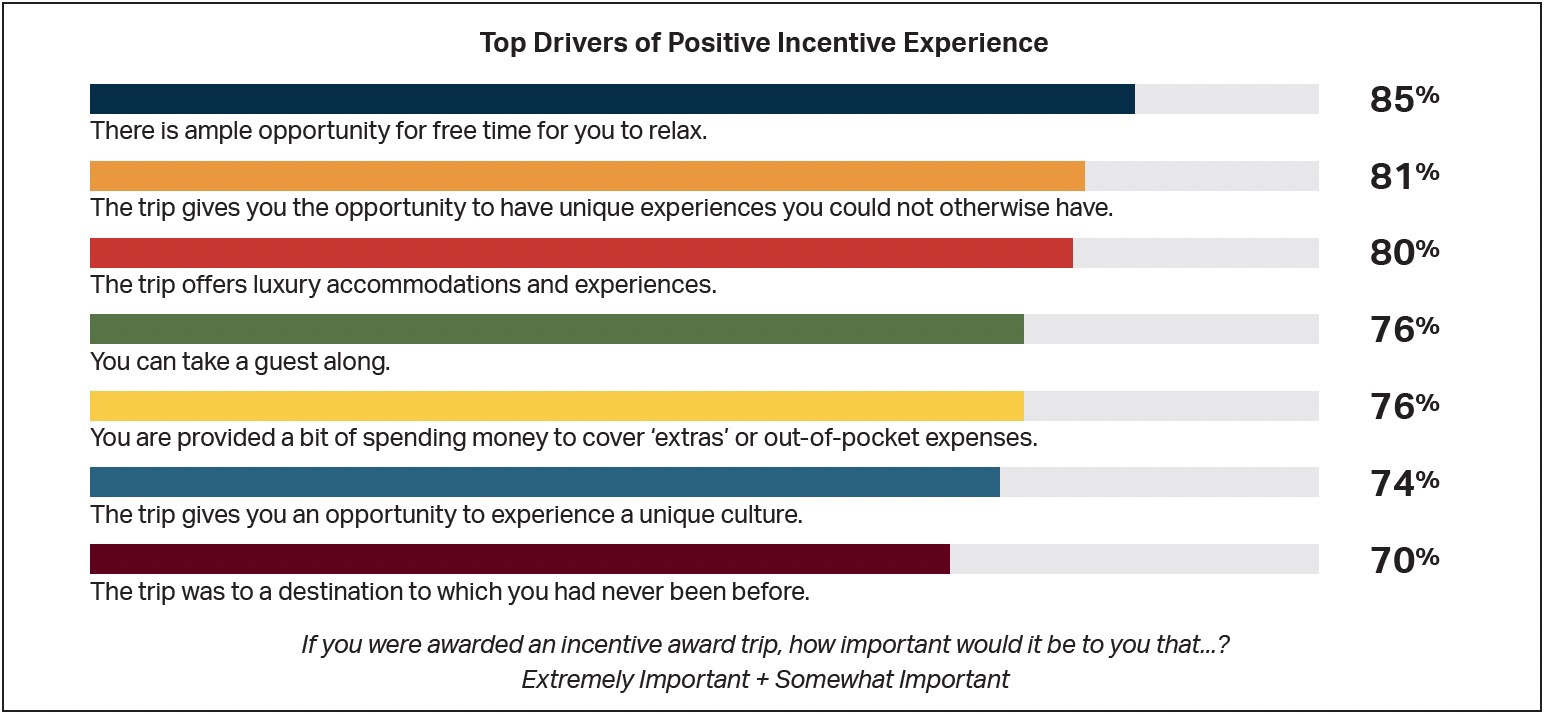More than any other non-cash incentive category, travel is one in which program planners must stay tuned into participants’ preferences. An incentive travel program is only as successful as the desirability of the destination and the attractiveness of the itinerary. To that end, we present this amalgamation of the most current research on incentive travel programs.
Desirability Remains High
A March survey by the Incentive Research Foundation of approximately 400 incentive program participants revealed that group travel is a lot like pizza — even when it’s not great, most people seem to like it.
According to the IRF’s 2024 Attendee Preferences for Incentive Travel, 91% of respondents describe a group incentive travel experience to an appealing destination as “very” or “extremely” motivating.
Hawaii, Las Vegas and Florida topped the list of most desirable North American destinations, as they have in previous IRF surveys. Notably, less-desired destinations such as Canada, Arizona and Mexico, still received significant support from survey respondents as desirable destinations they find motvational.
A Good Fit for Today’s Multigenerational Workforce
The IRF survey found that while appeal is high across all segments of comparison, younger age groups (Gen Z and millennials) find even greater motivation in group incentive travel than the older age groups. This is likely partially the result of older workers having had more opportunities to experience travel programs during their work tenure. Also, several studies show that, in an era of full-time remote and hybrid work set-ups, younger workers embrace camaraderie, mentorship and team building more than their older colleagues.

Emphasize New Experiences
Writing for a 2024 meetings and incentive travel trend report produced by Skift Meetings, Nikki Paterson, business solutions manager of Tourism Northern Ireland, states, “There is a growing emphasis on experiential travel rather than traditional luxury accommodations or activities. Participants are now seeking unique experiences that provide cultural immersion, adventure or opportunities for personal growth.”
The IRF survey of program participants reports the top driver of a positive experience is free time to relax followed by the trip providing an opportunity to have unique experiences that would not otherwise be possible.
Because participants undoubtedly have varying interests, an incentive travel program agenda should provide a choice of unique activities to suit several different travel styles, from adventure activity lovers to education seekers who want to learn more about the local history and culture.
VIP Treatment
This ties directly to the desire for new experiences. The third-highest factor for a driver of a positive experience in the IRF survey is luxury accommodations. Participants cited a private unit that is part of a larger resort, an all-inclusive resort or a large, well-known five-star hotel as the types of accommodation that can make a significant difference to the overall experience.
Evidence of this desire for luxury is seen in the consumer world. Eventbrite, an event management and ticketing company, reports that Attendance at events mentioning “VIP” grew globally by 18% on the Eventbrite platform between January and September 2023, compared to the same period in 2022.
“The importance of providing something extra at an event cannot be overstated. Extra touches could include surprise performances, exclusive access or complimentary offerings. These elements contribute to a more positive emotional experience, making attendees feel valued and appreciated,” one event organizer told Eventbrite.

Ideal Length of Time
If you’re treating top performers to a trip, they want it to be worth their time. Not surprisingly, participants request a longer trip when traveling to international destinations. Within North America, respondents said the ideal length is four to six days (52%), with 33% desiring seven to 10 days. For international incentive travel programs, 40% request seven to 10 days, another 23% says 10 days, and another 20% desire more than 10 days.
“Trip duration is a design consideration for which planners are challenged to balance attendee preference with budget and business realities. Cvent data indicates that most trip bookings (79%) are between four and six days, with only 15% of trips scheduled for a week or more.,” the IRF reports.
Beach and Sun
The features that incentive travel recipients desire most in a destination isn’t a shocker — a nice beach and sunny weather. Also listed in order were adventure travel; mountains; a historical location; and a wooded or nature area.
A Need-to-Have Strategic Tool
According to the 2023 Incentive Travel Index, when senior leaders were asked whether they view incentive travel as a must-have strategy, 53% stated it is essential to driving profits and 48% agreed it can serve as an competitive differentiator. Twenty-one percent of senior executives polled said incentive travel was a “necessary evil” they are afraid to cut.
With continued tight job markets in several competitive industries, there is evidence that companies feel the need to keep incentive travel budgets high to attract and retain top talent, said Ashley Bohnenkamp, senior manager of event solutions at ITA Group, an incentive program provider.
What About Individual Incentive Travel?
Incentive travel program participants clearly desire to bring a guest on any trip they receive as a reward, and most companies are allotting that in their budgets. There is also increasing interest in individual incentive travel rewards, in which recipients choose their own destination and travel at a time of their choosing. Anecdotally, individual incentive travel is desired more by older workers who have often participated in a number of group travel events.
Individual incentive travel incentives may be desired by a growing number of recipients, but companies remain hesitant to use them, according to the Incentive Travel Index. Group incentive travel provides team building experiences that individual incentive travel does not.





